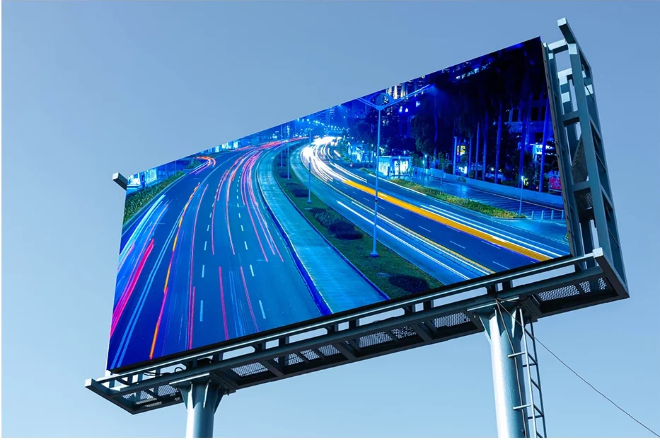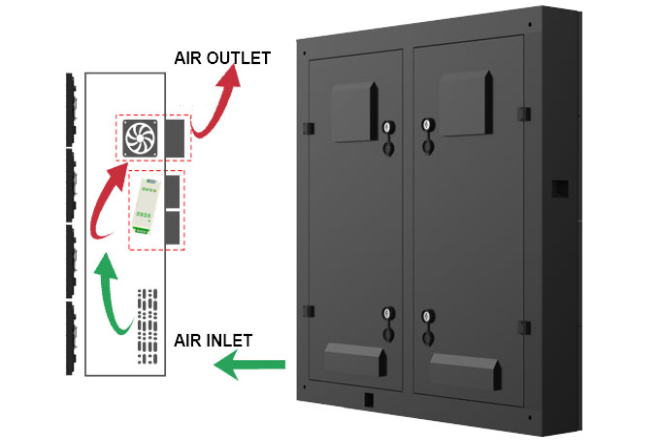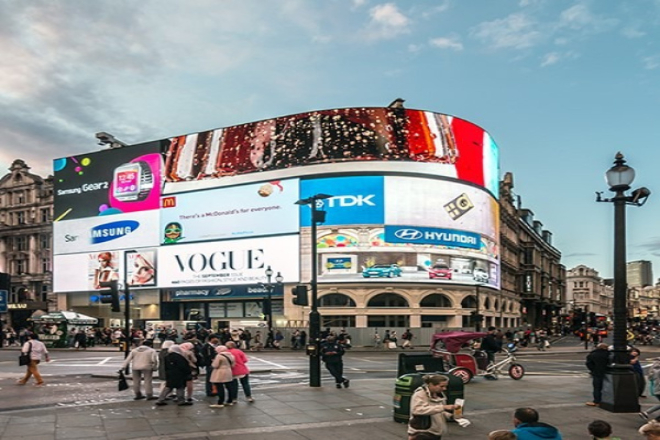소개

When we buy LED 디스플레이, we often hear words like “this LED display has good heat dissipation.” Why do you say that? Is heat dissipation very important for LED displays? This article tells you the answer.
목차
1. A brief introduction to the heat dissipation mechanism of LED displays
LED displays generate heat during operation. If the heat cannot be dissipated in time, the temperature of the LED chip will rise, which will affect its luminous efficiency and life.
Therefore, the heat dissipation mechanism is a very important part of the design of LED displays.
The heat of LED displays mainly comes from LED chips, drive circuits, and power modules.
1.1). LED chip heat generation:
When LED chips emit light, not all electrical energy can be converted into light energy, and a large part of it will be converted into heat energy.
Generally speaking, the electro-optical conversion efficiency of LED chips is about 30% – 40%. That is, 60% – 70% of the input electrical energy is converted into heat.
Moreover, the higher the temperature of the chip, the lower its luminous efficiency.
For example, an LED chip works well at normal temperature, but when its temperature rises due to poor heat dissipation, the light it emits will become dimmer, and the color may become inaccurate.
It’s like a light bulb, which will become dimmer or even burn out if it is too hot.
1.2). Heat generation of the drive circuit and power module:
In addition to the LED chip, the drive circuit and power module will also generate heat. The drive circuit is like the “commander” of the LED chip.
It controls the working state of the chip, and in this process, it consumes some electricity and generates heat. The power module, on the other hand, has to convert the input electrical energy into electrical energy suitable for the LED chip.
This conversion process is not 100% efficient, and some of the electrical energy will be converted into heat and dissipated.
If all this heat is trapped inside, the entire LED display will be like a “small stove,” getting hotter and hotter.
2. Chain reactions that may be caused by insufficient heat dissipation of the LED display

If the LED display has poor heat dissipation, there will be many problems, just like dominoes, one falls, followed by a series of troubles. Let’s talk in detail about the chain reactions caused by insufficient heat dissipation.
1). The performance of LED chips is greatly reduced
1.1). 명도 becomes dim:
LED chips are very sensitive to temperature. Think about it: the chip works well at normal temperature, and the brightness is sufficient.
But if the heat dissipation is not good and the temperature rises, the brightness will become lower and lower.
예를 들어, 옥외 발광 다이오드 표시 스크린 will become gray and dim when the sun shines in the summer, and the heat dissipation cannot keep up.
The original bright picture becomes dim, and the content displayed cannot be seen clearly from a distance.
Data shows that for every 10°C increase in temperature, the luminous efficiency of the LED chip may decrease by 5%-10%. Once the brightness decreases, the effect of the entire display screen will be greatly reduced.
1.2). Color becomes messy:
The high temperature will also make the color of the LED chip deviate. It’s like painting. The color was adjusted well, but when the temperature rose, the pigment changed color.
Red may become orange, blue may become purple, and the color of the entire display screen will be messed up.
In some occasions where color requirements are particularly high, such as LED displays used in 단계 performances and art 전시회, if the color is not accurate, the effect will be completely ruined.
1.3). Lifespan is greatly shortened:
LED chips are like people. Their “bodies” will age faster in high-temperature environments. The higher the temperature, the faster the components inside the chip age and the shorter the lifespan.
An LED chip that can be used for 50,000 hours may break down after 20,000 hours if it works at high temperatures for a long time.
This is like a car that can run 200,000 kilometers, but if it often runs in bad road conditions and high temperatures, it may be scrapped after 100,000 kilometers.
2). The drive circuit is in a bad mood
2.1). Components break down at any time:
The resistors and capacitors in the drive circuit are like “little bombs” at high temperatures, and they may break down at any time. For example, electrolytic capacitors are particularly sensitive to temperature.
High temperatures will cause the electrolytes inside them to evaporate, reduce their capacity, and finally fail directly.
Once these components are broken, the drive circuit will not work properly, and the display will have various problems, such as flickering, screen distortion, etc.
2.2). Signal transmission is messed up:
The high temperature will also affect the stability of the drive circuit, making the signal transmission messy.
The image signal that should have been accurately transmitted may be distorted and delayed at high temperatures. Just like when we make a phone call, if the signal is not good, the sound will be intermittent and unclear.
If there is a problem with the signal transmission of the LED display, the picture will be stuck and deformed, seriously affecting the viewing experience.
2.3). Short circuit risk increases greatly:
High temperatures may also melt the solder joints on the circuit board, which is like the foundation of a house, which is loose, and it is easy to have problems. Once the solder joints melt, it may cause a short circuit in the circuit.
At the least, the display cannot work properly, and at the worst, it may cause safety accidents such as fire. Imagine if a large outdoor LED display caught fire due to a short circuit; the consequences would be disastrous.
3). Reduced efficiency of the power module
3.1). Energy consumption is rising:
The power module is like a “lazy man” at high temperatures, and its working efficiency becomes particularly low.
It can efficiently convert the input power into the power required by the display, but when the temperature is high, it consumes more power to maintain the output power.
For example, a power module is 90% efficient at room temperature, but it may only be 85% at high temperatures.
In this way, the energy consumption of the display will increase greatly, which will not only waste electricity but also increase operating costs.
3.2). Frequent triggering of overheating protection:
The power module generally has an overheating protection function. When the temperature is too high, it will automatically shut down to prevent damage.
But if the heat dissipation is not good and the temperature cannot be lowered, the overheating protection will be frequently triggered.
This is like a person who is too tired to work and needs to take a break at any time. If the power module is frequently shut down, the display will frequently restart or fail to start, seriously affecting normal use.
4). The overall performance of the display screen deteriorates
4.1). Uniformity becomes a mess:
Poor heat dissipation will cause different temperatures in different areas of the display screen, which is like a piece of cloth; some places are darker, and some places are lighter.
The temperature of the LED chips in different areas is different, and the luminous effect will be different, resulting in uneven brightness and color differences.
In some occasions where high display effects are required, such as advertising screens in 쇼핑몰 and scoreboards in 경기장, poor uniformity will make the entire display screen look particularly ugly.
4.2). Reduced contrast:
The high temperature will also affect the contrast of the LED. Contrast is like the layering of the picture. The higher the contrast, the clearer and more three-dimensional the picture.
However, insufficient heat dissipation will reduce the contrast, and the picture will become blurred and dull, like an ink painting without layers.
Looking at such a display screen will make your eyes tired, and it will be difficult to see the details in the picture.
4.3). Longer response time:
The response time of the LED chip will be longer at high temperatures. The response time is like the reaction speed of a person. The shorter the response time, the smoother the picture.
However, poor heat dissipation will make the response time longer, resulting in ghosting and afterimages in dynamic pictures.
For example, when watching a football game, the players’ movements are very fast, but because the display screen has a long response time, there will be a smear on the screen, just like the players are running in slow motion, which seriously affects the viewing experience.
5). Increased safety hazards
5.1). Increased fire risk:
High temperature is an important factor in causing fire. Poor heat dissipation will cause the insulation material inside the display screen to age.
Once the insulation material fails, a short circuit may occur, generating electric sparks and causing a fire. Especially in some crowded places, such as shopping malls and theaters, once a fire occurs, the consequences are disastrous.
5.2). Increased risk of electric shock:
High temperatures may also melt the outer skin of the wire and expose the metal wire inside. Once the metal wire is exposed, people may get an electric shock if they accidentally touch it.
Electric shock will not only cause harm to people but may also cause other safety accidents.
5.3). Serious electromagnetic interference:
The performance of electronic components is unstable at high temperatures, which may cause electromagnetic interference. Electromagnetic interference is like an invisible “noise” that affects the normal operation of surrounding equipment.
For example, in an office, if the LED display screen has poor heat dissipation and generates electromagnetic interference, it may cause the computer next to it to crash and the printer to fail to work properly.
3. What are the methods for cooling LED display screens?
Don’t worry about the heat dissipation of LED display screens, you can easily solve it yourself! The following methods are simple and practical, and you can operate them without professional tools.
1). Basic heat dissipation method:
1.1). Let the LED display screen “breathe”
- Method:
Remove all the debris piled around the display screen (such as cardboard boxes, rag dolls, green plants, etc.), and don’t let them block the air outlet and air inlet.
You can imagine that the display screen is like a person who needs to breathe fresh air. If it is surrounded by things, it will “suffocate,” and the temperature will naturally rise.
- Suitable scenes:
실내 LED 스크린, advertising LED screen at the door of the shop.
- 효과:
It’s like opening a window for the display screen, the heat can be dissipated faster, the screen temperature can be reduced by 3-5°C, and it will not be so hot to the touch.
And with air circulation, the components inside the display screen can also “breathe” more smoothly and have a longer life.
1.2). Keep the LED display “away from the wall.”
Method:
Don’t stick the display tightly against the wall, leave a few centimeters of space. If it is hung on the wall, you can add a bracket to keep it away from the wall.
You can think of the display as a toaster. If it is close to the wall, the heat cannot be dissipated, and the bread (here refers to the display) will be burnt (overheated).
- Suitable scenes:
Office LED display, conference room LED display
- 효과:
The air behind can flow, the heat dissipation efficiency is improved, the display is not easy to overheat, and the life span is longer.
And staying away from the wall can also prevent the moisture on the wall from affecting the display.
1.3). Don’t let the air outlet “suffocate”
- Method:
Don’t put anything in front of the display to block the air outlet, such as green plants, decorations, etc. The air outlet is like the “mouth” of the display. If it is blocked, the heat cannot be discharged, and the display will be “uncomfortable”.
- Suitable scenes:
Shopping guide screens in shopping malls and ordering screens in restaurants.
- 효과:
The air outlet is unblocked, the hot air can be discharged in time, the display screen works more stably, and will not “freeze” easily. In addition, air circulation can reduce the accumulation of dust inside the display screen.

2). Low-cost transformation method:
2.1). “Install a small fan” for the LED display screen
- Method:
Install a small fan behind or on the side of the display screen (USB interface is fine, plug it into the computer and you can use it), and blow it towards the screen.
You can think of the fan as a “small air conditioner” to send cool breezes to the display screen. If there is not enough space behind the display screen, you can buy an ultra-thin fan, or fix the fan on the bracket.
- Suitable scenes:
Small LED display screens, home theater screens.
- 효과:
When the fan blows, the heat will dissipate, and the screen temperature can drop by 5-8°C, just like installing a small air conditioner for the display screen, which is cool.
And the sound of the fan is generally very small, which will not affect the viewing experience.
2.2). Install an air conditioner for the display
- Method:
Install an air conditioner that can cool inside the structure of the outdoor LED display
- Suitable scene:
Outdoor rear maintenance LED advertising screen
- 효과:
The temperature of the entire LED display can be reduced by 6-10°C, and it is not afraid of sun exposure in summer.
3). Daily maintenance method
3.1). Regularly “bathe” the display
- Method:
Use a soft brush or vacuum cleaner to clean the dust behind the LED display, especially the fan and heat dissipation holes, and don’t let the dust block them.
Dust is like a “small cotton jacket”, wrapping the display tightly, so that the heat cannot be dissipated. You can find time every month to clean the back of the display.
- Frequency:
Clean at least once a month. If there is too much dust, the heat dissipation will be poor.
- 효과:
With less dust, the heat dissipation will be smoother, and the display will have a longer life, and there is no need to replace it with a new one.
In addition, cleaning the dust can prevent the internal components of the display from being corroded.
3.2). Regularly check the “health” of the line
- Method:
Check whether the wires of the LED display are aging or damaged, especially the wires connecting the power supply and the fan.
If there is a problem, replace them quickly. The wires are like the “blood vessels” of the display screen.
If the blood vessels are blocked or broken, the display screen will “get sick.” You can check the circuit once a quarter to see if there are any black, hard, or broken areas.
- Frequency:
Check once a quarter; safety is the most important.
- 효과:
If there is no problem with the circuit, the cooling system can work normally, avoiding safety hazards and using it with more confidence. And regular inspection of the circuit can also prevent accidents such as fire.
3.3). Reasonable power on and off; don’t let it “get tired.”
- Method:
Turn off the display screen when not in use; don’t leave it on all the time, especially when sleeping at night or going out. The LED display screen is like a person, and it also needs rest. If it is always on, it will be “tired,” and its life will be shortened.
- Suitable scene:
Indoor LED display screen.
- 효과:
Reduce heat generation, extend the life of the display screen, and save electricity, killing two birds with one stone. Reasonable power on and off can also reduce the wear of the internal components of the display screen.
4. What is the core challenge of the heat dissipation design of LED display screens?
The heat dissipation design of LED display screens is not a simple matter. It needs to find a balance in many aspects. Let’s talk about these core challenges in detail.
1). Balance between structure and heat dissipation
1.1). The contradiction between ultra-thin trend and heat dissipation space
Nowadays, everyone likes ultra-thin and lightweight LED display screens. This appearance is good-looking, but it brings great trouble to heat dissipation.
Think about it: the thinner the display screen is, the less space is left for heat dissipation.
It’s like a small room. Originally, a large air conditioner could be placed to cool down, but now only a small fan can be placed.
Can the heat dissipation effect be the same? Designers must rack their brains to design an efficient heat dissipation structure in such a small space, such as making the radiator thinner and denser or using some new heat dissipation materials.
That the heat can be dissipated in time to ensure the normal operation of the display.
1.2). The trade-off between sealing and heat dissipation efficiency (waterproof design of outdoor screen)
Outdoor LED display screens must be waterproof. Otherwise, they will be broken when it rains, so sealing is very important.
But if the seal is tight, the heat can’t get out, and the heat dissipation efficiency is greatly reduced.
This is like putting a raincoat on the display screen. Although it can prevent rain, it is so hot that it “sweats” but can’t dissipate.
Designers need to find a balance between waterproofing and heat dissipation, such as using special sealing materials and structures.
Ensure waterproofing while allowing heat to have a certain heat dissipation channel, or design some clever heat dissipation channels inside the display to allow heat to dissipate along these channels.
2) 환경적 적응성
2.1). Attenuation of heat dissipation efficiency in high temperature and high humidity environments
In high temperature and high humidity environments, the heat dissipation efficiency of LED displays will be greatly reduced. The high temperature will make the heat dissipation material “lazy” and reduce work efficiency.
High humidity will make the air sticky, and heat will not be easily dissipated. It’s like a person in a stuffy and hot environment feeling uncomfortable all over, and working efficiency will also be reduced.
In addition, high humidity may also cause safety problems, such as short circuits inside the display screen.
Therefore, designers need to find ways to make the display screen work normally in a high temperature and high humidity environment.
For example, use heat dissipation materials that are resistant to high temperature and high humidity or design some special heat dissipation structures to dissipate heat faster.
2.2). Thermal stress caused by extreme temperature differences
LED display screens may encounter extreme temperature differences during use, such as moving from the cold outdoors to the warm indoors.
This temperature difference will cause thermal stress inside the display screen, just like applying an invisible force to the display screen.
Over time, the performance and life of the display screen will be affected. It’s like a piece of glass, which is easy to break if it is hot and cold.
Designers have to consider how to alleviate this thermal stress, such as using elastic materials or designing some structures that can absorb thermal stress so that the display screen can remain stable under extreme temperature differences.
3). The game between cost and performance
3.1). Cost pressure of high-end heat dissipation materials
In order to improve heat dissipation efficiency, some high-end heat dissipation materials are used in LED displays, such as nanofluids and phase change materials.
These materials are indeed easy to use and have a great heat dissipation effect, but the price is not cheap. This is like buying a luxury car.
The performance is good, but the price is prohibitive. Designers have to find ways to reduce costs while ensuring heat dissipation performance.
For example, see if some cost-effective materials can be used to replace these high-end materials or, by optimizing the heat dissipation structure, reduce the amount of materials used, thereby reducing the overall cost.
3.2). Energy consumption of active heat dissipation system
Active heat dissipation systems, such as fans and water cooling, can indeed improve heat dissipation efficiency, but they will also increase the energy consumption of the display.
This is like a person running to exercise the body, but it will also consume more energy.
While pursuing high performance, designers have to find ways to reduce energy consumption and improve energy efficiency.
For example, use more energy-saving fans or water pumps or design some intelligent control systems.
Adjust the working power of the cooling system according to the actual working temperature of the display, so that the display can find an optimal balance between heat dissipation and energy consumption.
In short, the heat dissipation design of LED display screens is a complex and challenging task.
Designers have to find a balance in multiple aspects such as structure, environment, and cost to make the display screen both beautiful and practical, efficient and energy-saving.
5. The innovative breakthroughs in the heat dissipation technology of LED displays

The innovative breakthroughs in the heat dissipation technology of LED displays have really brought earth-shaking changes to this industry.
In the past, we always had a headache about the heat dissipation problem of LED displays.
Now, with the emergence of new tricks such as material innovation, structural optimization, and intelligent thermal management, the heat dissipation problem is no longer a problem, and LED displays can also work “coolly and quickly.”
1). Material innovation:
1.1). Graphene and carbon nanotubes:
Graphene and carbon nanotubes are two names that sound very high-tech. They are like “superheroes” in the heat dissipation world, with super thermal conductivity.
Graphene is simply a “dark horse” in heat dissipation materials. It is a thin layer, but its thermal conductivity is amazing. Carbon nanotubes are not to be outdone, and their thermal conductivity is also excellent.
With the addition of the two of them, the heat dissipation efficiency of LED displays has risen sharply, and there is no need to worry about the display screen “going on strike” due to overheating.
1.2). New composite materials:
In addition to graphene and carbon nanotubes, new composite materials are also shining in the field of heat dissipation. Ceramic substrates and metal-based composite materials, these names sound quite “hardcore.”
They not only have good thermal conductivity but also have excellent mechanical properties and chemical stability.
Just like the “all-round player” of heat dissipation, no matter what kind of environment they face, they can easily cope with it and ensure the stable operation of the LED display.
2). Structural optimization:
2.1). 3D stacking technology:
3D stacking technology is simply a “multiplier” of heat dissipation space. In the past, LED display screens were ultra-thin, and the heat dissipation space was limited, so the heat dissipation efficiency could not be improved.
Now, with 3D stacking technology, the LED chip and the heat dissipation structure can be closely combined, just like “creating” more heat dissipation area in a limited space.
In this way, the heat dissipation efficiency will naturally increase, and the LED display screen can work more “coolly.”
2.2). Bionic design:
Bionic design is the “natural inspiration” in the field of heat dissipation. Scientists have found inspiration for heat dissipation from creatures in nature, such as the design of imitating the surface structure of shark skin.
The tiny lines on the surface of shark skin can optimize water flow and reduce resistance. Similarly, applying this design to the heat dissipation of LED display screens can also optimize airflow and improve heat dissipation efficiency.
It’s like putting a “heat dissipation coat” on the LED display screen, allowing it to dissipate heat more efficiently.
6. 결론
In general, heat dissipation is not only related to the performance stability of LED display screens, but also directly affects its safety and service life.
Correctly understanding the importance of heat dissipation and choosing the right heat dissipation solution are the core issues that every LED display screen designer and operator must pay attention to.
마지막으로 LED 디스플레이 화면에 대해 더 알고 싶다면, 문의하시기 바랍니다.
